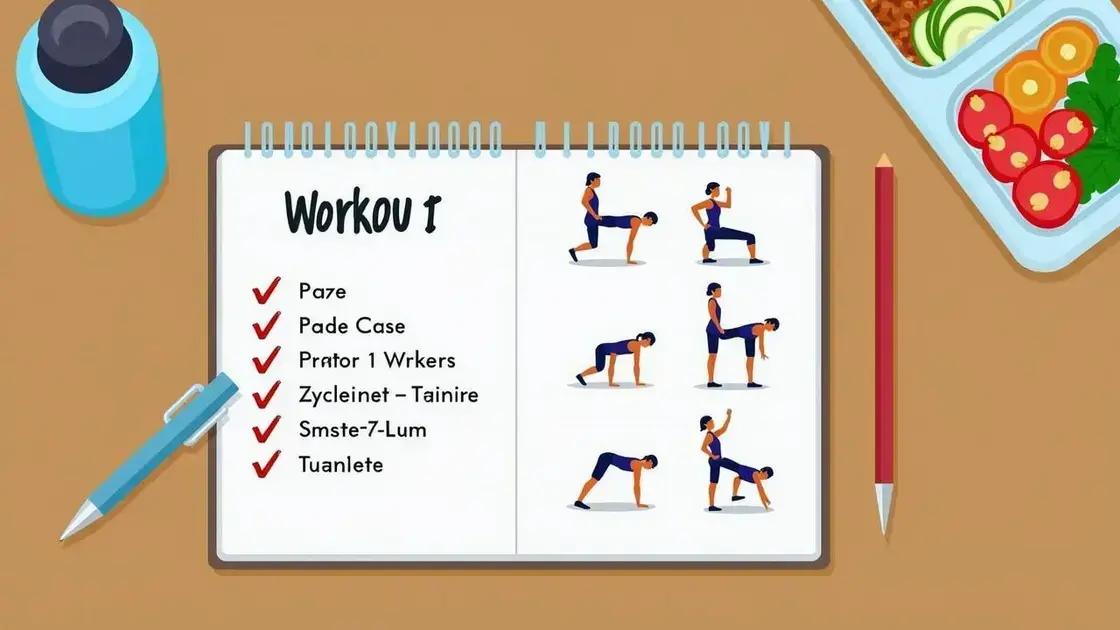Preventing overtraining in your 50s involves understanding its signs, implementing best practices such as prioritizing recovery, and creating a balanced workout plan that includes diverse exercises, adequate hydration, and nutrition.
Overtraining can be a serious concern for anyone, especially those in their 50s looking to maintain an active lifestyle. Knowing how to prevent overtraining in your 50s is key to sustaining your health and enjoying your workouts. This article will guide you through the signs of overtraining, effective strategies to avoid it, and how to create a balanced workout plan that keeps you fit and safe.
Understanding Overtraining

Understanding overtraining is crucial, especially for those in their 50s who want to maintain their health and fitness. Overtraining occurs when the body is subjected to excessive training without adequate recovery. It can lead to diminished performance, fatigue, and even injury.
When engaging in regular exercise, the body needs time to repair and recover. If this recovery time is neglected, it can disrupt the balance between training and recovery, resulting in overtraining syndrome (OTS).
Causes of Overtraining
Several factors can contribute to overtraining, including:
- High training volume: Engaging in too many workouts without rest can exhaust the body.
- Insufficient rest: Not allowing enough time for recovery can prevent muscles from healing properly.
- Poor nutrition: Failing to fuel the body with the right nutrients can hinder its recovery process.
- Stress: High levels of stress from daily life can impact physical resilience, making recovery harder.
Understanding these causes is essential for preventing overtraining. By knowing what to watch for, you can take proactive measures to maintain a balanced fitness routine.
The Role of Age
As we age, our bodies naturally require more recovery time compared to younger individuals. This makes it even more important for those in their 50s to recognize the signs and symptoms of overtraining. Emphasizing recovery techniques such as stretching, hydration, and restful sleep can greatly support overall fitness.
By remaining aware of your training intensity and ensuring that your body gets enough time to recuperate, you can enjoy a healthy and sustainable approach to fitness.
Signs of Overtraining to Watch For

Identifying the signs of overtraining is vital for anyone, especially for those in their 50s. Recognizing these signs early can help you modify your training schedule and prioritize recovery.
1. Persistent Fatigue: If you find yourself feeling tired even after rest days, this may be a sign of overtraining. Feeling drained can hinder your performance and motivation.
2. Decreased Performance: A sudden drop in athletic performance can indicate overtraining. If your usual workout intensity seems much harder, it’s essential to evaluate your training load.
3. Sleep Disturbances: Trouble sleeping or inconsistent sleep patterns can be linked to overtraining. Quality rest is crucial for recovery, and any disruption can affect your overall health.
4. Mood Changes: Increased feelings of irritability or anxiety can also reflect overtraining. Mental fatigue affects motivation and can make workouts less enjoyable.
5. Increased Injuries: Frequent injuries or muscle soreness that doesn’t go away could be a sign that your body has not fully recovered from previous workouts.
6. Changes in Appetite: A noticeable increase or decrease in appetite can signal that your body is stressed. Overtraining can disrupt your metabolism and influence hunger signals.
Being aware of these signs can help you take action before overtraining becomes a larger issue. Monitoring how your body feels during and after workouts is essential.
Best Practices to Avoid Overtraining

To avoid overtraining, especially in your 50s, it’s essential to adopt best practices that promote recovery and balance in your exercise routine.
1. Prioritize Recovery: Allow your body enough time to rest and recover. Schedule rest days in your workout routine to give your muscles a break from stress.
2. Listen to Your Body: Pay attention to how you feel during and after workouts. If you’re feeling unusually fatigued or sore, it may be time to adjust your intensity or take an extra day off.
3. Vary Your Workouts: Incorporating different types of exercises can help prevent overtraining. Mix strength training, cardio, and flexibility workouts to keep your routine fresh and engaging.
4. Stay Hydrated and Nourished: Eating a balanced diet rich in proteins, carbs, and healthy fats is crucial for recovery. Proper hydration helps your body function efficiently and aids in the recovery process.
5. Monitor Your Progress: Keep track of your workouts and progress. This can help you identify any patterns that may lead to overtraining and allow you to make necessary adjustments.
6. Incorporate Active Recovery: On rest days, engage in light activities such as walking or gentle yoga. It can help keep your body moving without placing stress on your muscles.
By integrating these best practices into your routine, you can effectively minimize the risk of overtraining and maintain a healthier workout regimen.
Creating a Balanced Workout Plan

Creating a balanced workout plan is essential for those in their 50s seeking to avoid overtraining. A well-rounded plan should incorporate various elements to promote overall fitness and recovery.
1. Include Different Types of Exercise: Your plan should consist of strength training, cardiovascular workouts, and flexibility exercises. Aim for at least two days of strength training each week and include aerobic activities like walking, swimming, or cycling on most days.
2. Set Realistic Goals: Establish achievable fitness goals based on your current fitness level. Instead of pushing too hard, aim for gradual improvements. This will help maintain motivation and prevent burnout.
3. Schedule Rest Days: Incorporate rest or active recovery days into your weekly plan. This can include light activities, such as yoga or leisurely walks, to help your body recover without complete inactivity.
4. Listen and Adapt: Pay attention to how your body responds to workouts. If you’re feeling excessively fatigued or not recovering fast enough, be ready to adjust your plan. It’s okay to take it easy or change your routine as needed.
5. Hydration and Nutrition: Ensure you drink plenty of water before, during, and after workouts. Additionally, maintain a well-balanced diet filled with fruits, vegetables, lean proteins, and whole grains to fuel your body effectively.
By focusing on these aspects, you can create a balanced workout plan that supports your fitness journey and reduces the risk of overtraining.
In Summary: How to Prevent Overtraining in Your 50s
Preventing overtraining is essential for maintaining a healthy and active lifestyle in your 50s. By understanding what overtraining is and recognizing the signs, you can make informed decisions about your workouts.
Implementing best practices, such as prioritizing recovery, listening to your body, and creating a balanced workout plan, will help you stay fit without the risk of injury or burnout.
Remember, your fitness journey is unique, and it’s vital to adapt your approach as needed. With careful planning and mindfulness, you can enjoy an active and fulfilling life as you age.
FAQ – Frequently Asked Questions about Preventing Overtraining in Your 50s
What is overtraining, and how can I recognize it?
Overtraining occurs when you exercise too much without adequate recovery. Signs include persistent fatigue, decreased performance, mood changes, and frequent injuries.
How can I create a balanced workout plan?
A balanced workout plan should include strength training, cardiovascular exercises, flexibility workouts, and rest days. Adjust your routine based on your body’s feedback.
What are some best practices to avoid overtraining?
Prioritize recovery, listen to your body, vary your workouts, stay hydrated, and eat a balanced diet to help prevent overtraining.
How do I know if I need a rest day?
If you’re feeling unusually fatigued, sore, or have a decreased performance, it’s a good indication that you may need a rest day.
Is it important to stay hydrated during workouts?
Yes, staying hydrated is crucial for overall performance, recovery, and to reduce the risk of injury while exercising.
Can older adults still participate in high-intensity workouts?
Yes, many older adults can engage in high-intensity workouts, but it’s essential to listen to your body and ensure adequate recovery between sessions.












